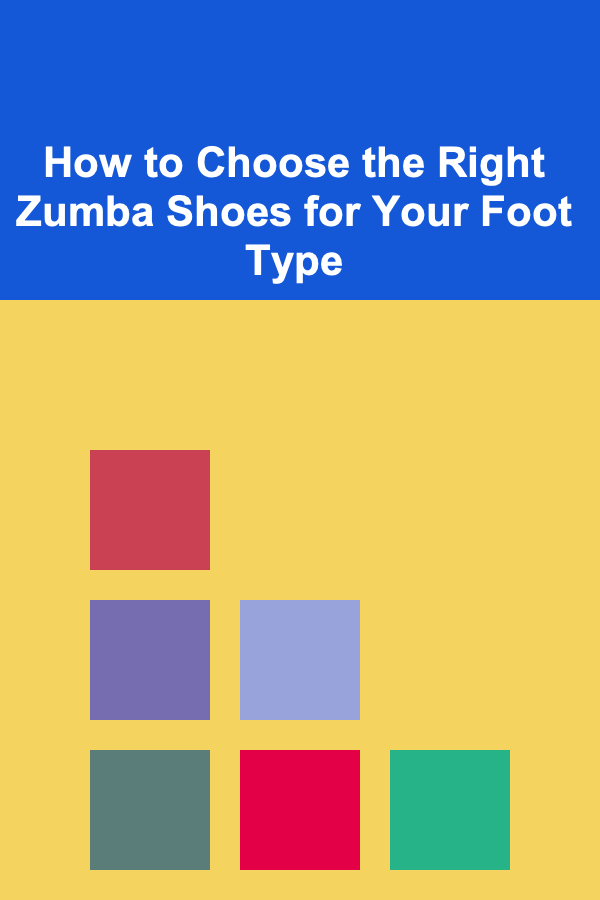
How to Choose the Right Zumba Shoes for Your Foot Type
ebook include PDF & Audio bundle (Micro Guide)
$12.99$11.99
Limited Time Offer! Order within the next:

When it comes to Zumba, choosing the right pair of shoes is as essential as selecting the right workout routine. The dynamic and high-impact movements that Zumba involves---whether it's salsa, hip-hop, reggaeton, or other dance forms---put a significant amount of strain on your feet. Wearing the wrong shoes can lead to discomfort, injury, and poor performance. Since everyone's foot type is different, understanding how to match your foot's unique characteristics with the appropriate Zumba shoes is crucial for both comfort and performance.
In this article, we will discuss the key factors you need to consider when selecting Zumba shoes based on your foot type. We will cover different types of feet, what makes a good Zumba shoe, and how to assess which shoe works best for your individual needs.
Understanding Different Foot Types
The first step in choosing the right Zumba shoes is to understand your foot type. There are three main foot types: neutral , flat feet , and high arches. Each type requires specific features in shoes to ensure proper support and comfort. Let's take a closer look at each one.
1. Neutral Feet
Neutral feet are typically well-balanced, meaning that the arch of the foot forms a normal curve, neither too high nor too flat. Individuals with neutral feet usually have no issues with pronation (the natural inward rolling of the foot when walking or running), so their shoes don't need extra arch support or corrective features.
Key Features to Look for:
- Moderate cushioning: Neutral feet generally do well with shoes that offer moderate cushioning. Zumba requires fast foot movements, so a balance of cushioning and responsiveness is necessary.
- Flexibility: Neutral feet benefit from shoes that are flexible enough to allow a full range of motion but still offer stability.
- Lightweight construction: As neutral feet don't require as much corrective support, lightweight shoes can provide the speed and agility needed for fast-paced dance moves.
2. Flat Feet
People with flat feet (or overpronation) have low arches or no arch at all. This can result in the foot rolling inward too much when they move, which can lead to discomfort, fatigue, and even injuries if not addressed. Flat feet are more prone to strain during high-impact activities like Zumba.
Key Features to Look for:
- Arch support: Flat-footed individuals need shoes that offer sufficient arch support to prevent overpronation. This helps to stabilize the foot and distribute the weight evenly during exercise.
- Stability and motion control: Look for shoes designed with stability or motion control features. These shoes are specifically built to minimize the inward rolling of the foot during high-impact movements.
- Firm cushioning: A more supportive midsole is essential for flat feet. Too soft of a cushioning can lead to a lack of stability, which might cause pain and discomfort over time.
3. High Arches
On the opposite side, individuals with high arches have less surface area in contact with the ground, which can create problems with shock absorption. High arches are less flexible, and without proper support, they may put excess pressure on the forefoot and heel during exercise.
Key Features to Look for:
- Cushioning: High arches require shoes that provide ample cushioning, especially in the midsole and heel area. This helps to absorb shock and reduce the impact on the foot.
- Arch support: Even though high arches don't need as much correction as flat feet, they still need support to prevent excessive strain on the foot's natural arch. Shoes with extra arch support can help prevent foot fatigue and discomfort.
- Flexible and lightweight: Since high arches are more rigid, a flexible shoe that allows for natural movement is key. Look for shoes that combine cushioning with flexibility to ensure comfort and fluidity in movement.
Features of a Good Zumba Shoe
Beyond understanding your foot type, it's important to know the general features that make a good Zumba shoe. Zumba requires fast movements, pivots, and constant shifting of weight, so your shoes must be up to the task. Here are some key features that every Zumba shoe should have:
1. Support
Support is essential for protecting your feet during high-intensity movements. This means having proper arch support, a firm heel cup, and midfoot support. A shoe that provides the right level of support helps reduce the risk of injuries like sprains, strains, and plantar fasciitis.
2. Cushioning
A good Zumba shoe should offer proper cushioning to absorb shock. The intensity of the jumps, fast footwork, and high-impact movements in Zumba require cushioning to protect your joints and muscles. However, too much cushioning can also make the shoe less stable, so finding the right balance is key.
3. Traction
Zumba involves a lot of lateral (side-to-side) and pivoting movements. Shoes should have a non-marking rubber sole with enough traction to prevent slipping while also allowing smooth pivots. Excessive grip can make it harder to perform turns, so the sole should provide the right level of traction for a good balance between grip and slide.
4. Flexibility
Flexibility allows your feet to move naturally during Zumba. A shoe with a flexible midsole and forefoot enables you to twist, turn, and jump without being restricted by the shoe. This is especially important for those engaging in a variety of dance styles during a class.
5. Breathability
Zumba is a sweaty activity, so you need shoes that allow for proper airflow to keep your feet cool and dry. Materials like mesh or breathable synthetic fabrics are common in Zumba shoes and will help reduce the risk of blisters and discomfort caused by excess moisture.
6. Lightweight
Since Zumba requires rapid movement and frequent shifts in direction, having a lightweight shoe can reduce fatigue and enhance agility. Heavy shoes can slow you down and make it harder to execute swift movements.
How to Choose Zumba Shoes Based on Foot Type
1. For Neutral Feet
If you have neutral feet, you're in luck, as your foot type is the most versatile when it comes to Zumba shoes. You can opt for a variety of styles, but there are a few things to keep in mind:
- Look for a shoe that offers moderate cushioning to enhance comfort during high-impact movements.
- Choose lightweight options that allow you to move freely and don't weigh you down.
- Look for shoes that offer enough flexibility, especially around the toe area, to allow for quick pivots and jumps.
- Consider shoes with a smooth, non-marking sole that offers enough traction but allows for smooth sliding during turns.
Popular Zumba shoe brands for neutral feet include Nike , Reebok , and Asics, all of which offer models with balanced cushioning and flexibility suitable for this foot type.
2. For Flat Feet
Flat feet require shoes with more support and stability to correct the inward rolling motion (overpronation). The right Zumba shoe can help mitigate the negative effects of flat feet during intense exercise.
- Choose shoes with good arch support to prevent your feet from rolling inward. Look for shoes specifically designed for stability or motion control.
- Opt for shoes with a firmer midsole to avoid excess flexibility, which can worsen instability in flat feet.
- Ensure the shoe has a snug fit, especially around the arch area, to provide adequate support during lateral movements.
- Consider shoes with extra cushioning to absorb shock and reduce the pressure on your feet during jumps and quick footwork.
For flat feet, look into Zumba shoes from brands like Brooks , Saucony , or New Balance, as these brands often design shoes with superior motion control and support.
3. For High Arches
High arches tend to require extra cushioning and support, particularly in the midsole and heel area. Without these features, individuals with high arches may experience foot pain or fatigue after a Zumba session.
- Look for shoes with ample cushioning in the midsole to absorb impact and prevent pressure from building up on your feet.
- Choose shoes with a soft, flexible upper to allow for natural foot movement without restriction.
- Ensure the shoes provide adequate arch support to prevent strain on the feet and reduce discomfort during extended use.
- Consider shoes with a neutral or minimal arch support depending on your specific needs, as too much arch support can create discomfort for those with high arches.
Brands like Saucony , Nike , and Brooks offer shoes that are well-suited for individuals with high arches, offering a good balance of cushioning, flexibility, and support.
Conclusion
Choosing the right Zumba shoes based on your foot type is essential for ensuring comfort, support, and injury prevention during your workouts. Whether you have neutral feet, flat feet, or high arches, understanding your foot's unique needs is the first step in selecting the perfect shoe. By focusing on key features such as support, cushioning, flexibility, and traction, you can find a pair of shoes that will help you perform your best in every Zumba class.
Remember that everyone's feet are different, and what works for one person might not work for another. It's essential to try on several options, pay attention to how your feet feel during movement, and select shoes that complement your foot type and enhance your Zumba experience. With the right footwear, you can dance with confidence, comfort, and joy, knowing your feet are well taken care of.
Reading More From Our Other Websites
- [Digital Decluttering Tip 101] Best Digital Decluttering for Writers: Eliminate Distractions & Fuel Your Creativity
- [Home Soundproofing 101] How to Use Acoustic Panels to Improve Your Home Soundproofing
- [Beachcombing Tip 101] 10 Must-Know Beachcombing Hacks for Finding Hidden Treasures
- [Organization Tip 101] What Should You Include in Your Home Organization Plan?
- [Digital Decluttering Tip 101] Mastering Digital Clutter: Proven Strategies for Streamlined File Organization
- [Personal Care Tips 101] How to Use Micellar Water as a Gentle Makeup Remover
- [Home Party Planning 101] How to Plan a Themed Costume Party That Everyone Will Love
- [Stamp Making Tip 101] Streamlining Operations: Using Business Stamps to Save Time and Ensure Consistency
- [Personal Finance Management 101] How to Manage Your Finances as a Freelancer
- [Home Space Saving 101] How to Turn Underused Spaces into Storage Areas

How to Build a Checklist for Analyzing Your Email Campaign Performance
Read More
How to Keep Track of Home Maintenance Expenses
Read More
How to Stage Your Home to Appeal to Millennial Buyers
Read More
Understanding the Role of Vitamins and Minerals
Read More
Creativity and Children Feng Shui: Nurturing Inspiration
Read More
How to Style Short Hair in Multiple Ways
Read MoreOther Products

How to Build a Checklist for Analyzing Your Email Campaign Performance
Read More
How to Keep Track of Home Maintenance Expenses
Read More
How to Stage Your Home to Appeal to Millennial Buyers
Read More
Understanding the Role of Vitamins and Minerals
Read More
Creativity and Children Feng Shui: Nurturing Inspiration
Read More